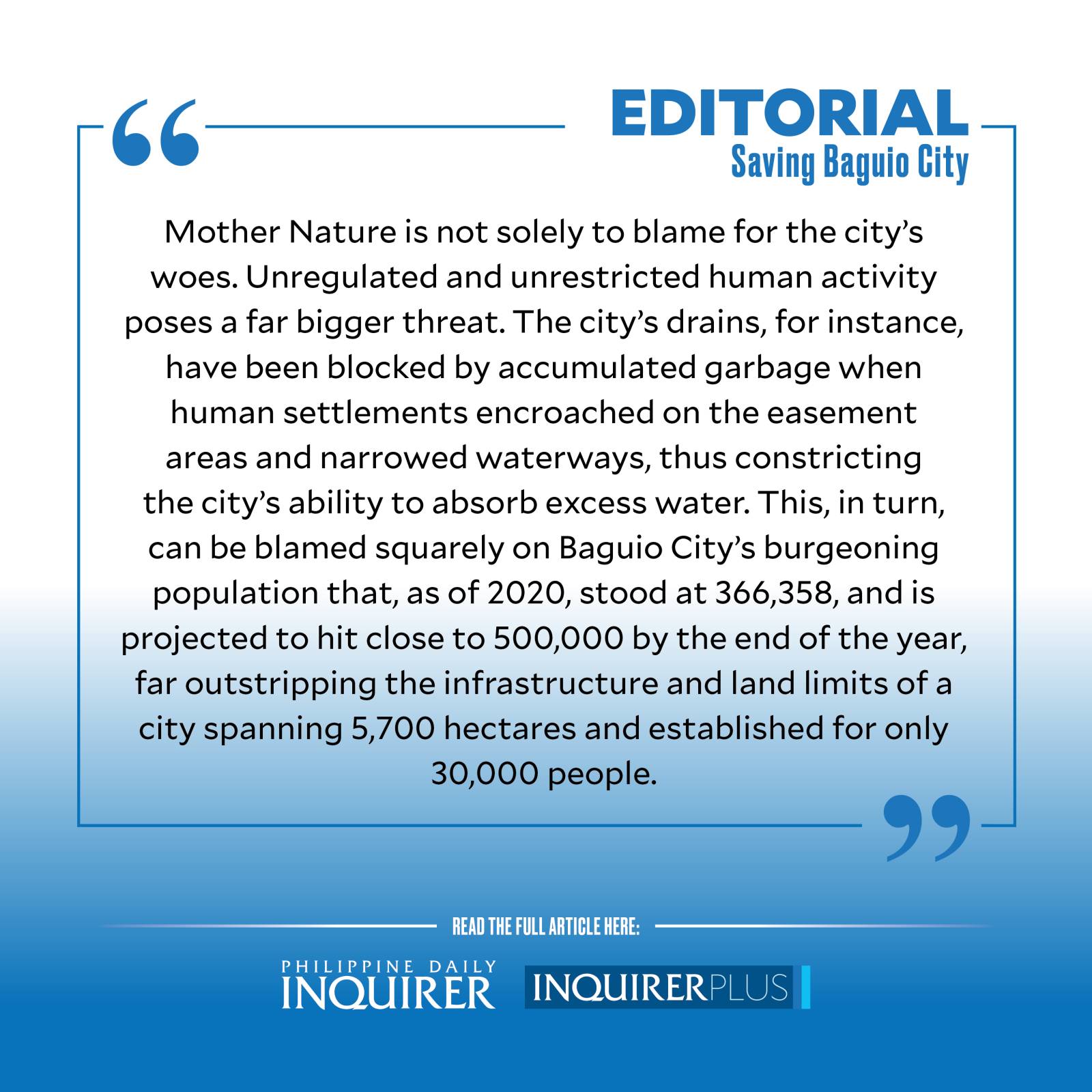Saving Baguio City
Postcard-perfect images that showcase Baguio City’s status as the Summer Capital of the Philippines hide the bitter reality that it is a most vulnerable city when it comes to the harsh effects of climate change, particularly excessive rainfall, with its resulting widespread flooding, and deadly landslides. And unless concrete, time-bound, and science-based steps are immediately taken, these manifestations of environmental crisis on this tourist, trade, and education center in the Cordillera Administrative Region, are bound to get worse.
Baguio City already holds the distinction of getting the most rainfall in the Philippines, with the average annual volume steadily rising over the past 20 years. And projections are that the volume will increase even more, by an alarming 23 percent over the next 10 years, according to Baguio City Mayor Benjamin Magalong, no thanks to harmful greenhouse gas emissions such as carbon dioxide. These emissions warm up the atmosphere and lead to extreme weather patterns, including stronger and more frequent typhoons.
During the Feb. 9 Baguio Climate Change Summit, Magalong stressed that the city has to reduce greenhouse gas emissions by 30 percent in 2030, and work down to zero emissions by 2050, to protect the city against the severe impact of climate change seen in more intense rains. The mayor cited the 2020 annual report of the Asian Development Bank’s (ADB) Urban Financing Partnership Facility Group, which warned that climate change “is only expected to exacerbate rain-induced landslides and flooding events due to the frequency and intensity of rainfall in the city.”
This is a terrifying prospect, considering that as much as 80 percent of the city is prone to landslides, according to a separate 2021 report of the ADB. These landslides can be triggered as well by earthquakes, since Baguio City is crisscrossed by seismic faults and lies on a tectonically active area. That the city is teetering on the edge of a climate precipice has been known as early as 2011, when it was tagged as the most exposed and vulnerable to extreme weather events compared to other major cities in the Philippines. And excessive rainfall is enemy number one.
“Rain is going to be Baguio’s bane,” said the Business Risk Assessment and the Management of Climate Change Impacts study conducted by the World Wide Fund Philippines (WWF) and the Bank of the Philippine Islands Foundation, Inc. “Extreme rainfall and intensified tropical cyclones will continue to define the city’s future. It is likely that Baguio will go from wet, to wetter,” the study stressed. Baguio City has enough proof of the devastation that flooding and landslides can cause. In 2018, for example, Typhoon “Ompong” lashed Northern Luzon and caused raging floods and landslides in Baguio City, killing 11 people and causing access road closures as well as significant damage to properties.
But Mother Nature is not solely to blame for the city’s woes. Unregulated and unrestricted human activity poses a far bigger threat. The city’s drains, for instance, have been blocked by accumulated garbage when human settlements encroached on the easement areas and narrowed waterways, thus constricting the city’s ability to absorb excess water. This, in turn, can be blamed squarely on Baguio City’s burgeoning population that, as of 2020, stood at 366,358, and is projected to hit close to 500,000 by the end of the year, far outstripping the infrastructure and land limits of a city spanning 5,700 hectares and established for only 30,000 people.
No wonder, then, that the city is ironically suffering from a grave water supply problem that is bound to become more acute. As the WWF study revealed, the city’s groundwater supply is now “grossly inadequate” since the pine forest that used to recharge the city’s aquifers has been felled. Add to this the fact that of the city’s six watersheds, two are no longer operable because of the unregulated influx of informal settlers. This is but one portent of the bleak future that awaits Baguio City, unless a multiyear program is put in place to reverse the “urban decay” that has blighted it.
Development plans have to be immediately revisited and redrawn, and desired reforms, such as the rapid reduction in the city’s greenhouse gas emissions, doggedly implemented given the present hazards caused by rapid and poorly planned urbanization. The right balance should be struck between the desired economic growth and the realities of climate change, urbanization trends, and the overarching need to manage the city’s watersheds, green spaces, and drainage system. Failure is not an option, for the very survival of Baguio City is at stake.





















